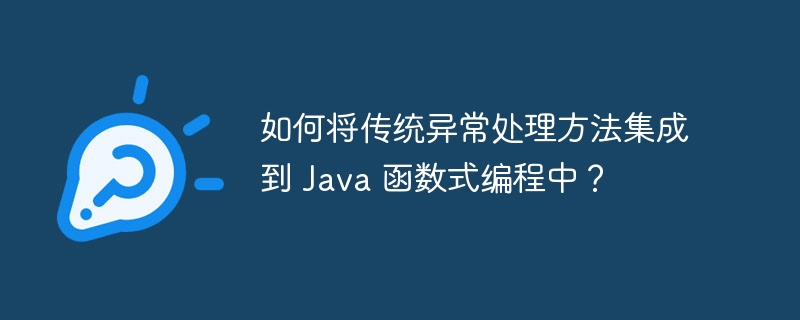在 java 函数式编程中集成传统异常处理方法可以采用多种方式:1. 使用检查异常(checked exceptions)将异常声明为抛出(throws)并使用 try-catch 语句捕获;2. 将检查异常转换为非检查异常(unchecked exception)并使用 completablefuture;3. 使用异常处理操作符如 handle() 和 optional 处理异常。

如何在 Java 函数式编程中集成传统异常处理方法
在 Java 函数式编程中,使用 lambda 表达式和流进行代码处理很常见。然而,这些构造与传统异常处理方法不兼容。本篇文章将介绍如何集成传统异常处理方法到 Java 函数式编程中。
1. 使用 Checked Exceptions
立即学习“Java免费学习笔记(深入)”;
检查异常是需要手动处理的异常,可以通过将它们声明为抛出(throws)的方式。在 lambda 表达式中,可以使用 try-catch 语句捕获检查异常。
Function<Integer, Integer> divide = (num) -> {
try {
return num / 2;
} catch (ArithmeticException e) {
throw new RuntimeException(e);
}
};2. 使用 Unchecked Exceptions
将检查异常转换为非检查异常(unchecked exception)可以简化异常处理。这是通过使用 CompletableFuture.supplyAsync(Supplier) 方法和将检查异常包装成非检查异常的方式实现的。
CompletableFuture<Integer> divide = CompletableFuture.supplyAsync(() -> {
try {
return number / 2;
} catch (ArithmeticException e) {
throw new RuntimeException(e); // 转换为非检查异常
}
});3. 使用 Exception Handling Operators
Java 8 引入了异常处理操作符,允许以链式的方式处理异常。可以使用 handle() 操作符处理异常,并返回一个带非检查异常的 Optional。
Stream<Integer> numbers = Stream.of(1, 2, 3, 4);
numbers
.map(num -> num / 2)
.handle((result, exception) -> {
if (exception != null) {
throw new RuntimeException(exception);
}
return result;
})
.forEach(System.out::println);实战案例
以下是一个使用流、lambda 表达式和传统异常处理方法从文件中读取数据的实战案例:
try {
Files.lines(Paths.get("data.txt"))
.map(line -> Integer.parseInt(line))
.reduce(Integer::sum)
.ifPresent(sum -> System.out.println("数据文件中的数字和为:" + sum));
} catch (IOException | NumberFormatException e) {
System.err.println("读取文件或转换数字时出错:" + e.getMessage());
}总之,这些技术使我们能够在 Java 函数式编程中集成传统异常处理方法,从而在处理异常时提供更多的灵活性和控制。
以上就是如何将传统异常处理方法集成到 Java 函数式编程中?的详细内容,更多请关注php中文网其它相关文章!

每个人都需要一台速度更快、更稳定的 PC。随着时间的推移,垃圾文件、旧注册表数据和不必要的后台进程会占用资源并降低性能。幸运的是,许多工具可以让 Windows 保持平稳运行。

Copyright 2014-2025 https://www.php.cn/ All Rights Reserved | php.cn | 湘ICP备2023035733号